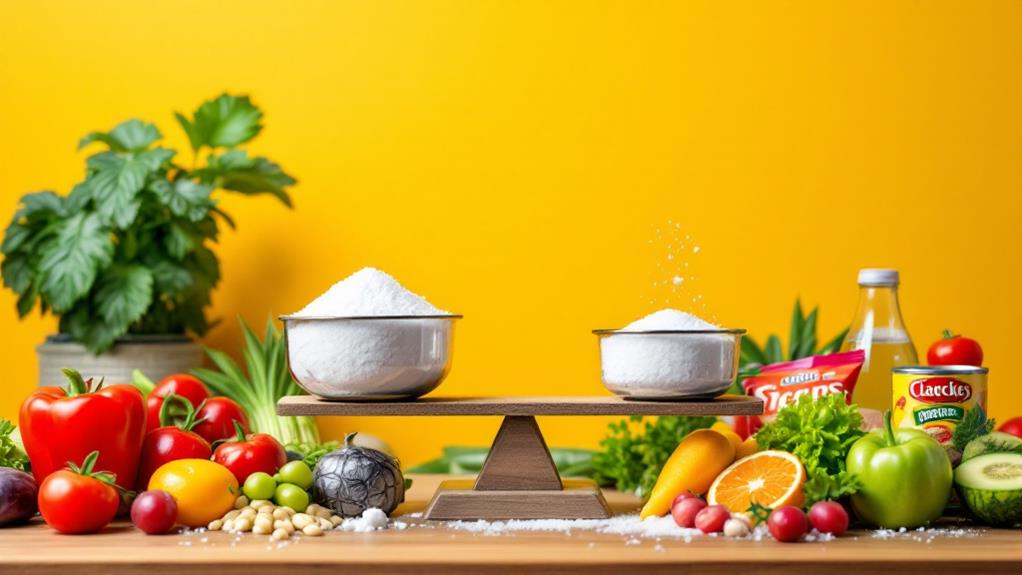The Ultimate Guide to Table Salt: Everything You Need to Know
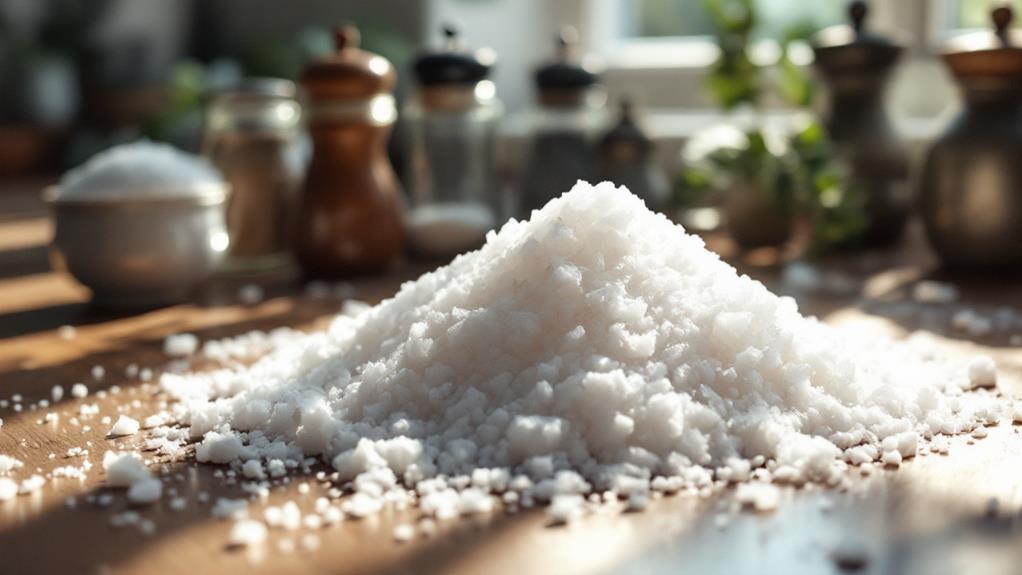
You're about to investigate the fundamental aspects of table salt, mainly composed of sodium chloride. It's refined for a sharp, consistent flavor that improves your culinary masterpieces. Added anti-caking agents keep it flowing smoothly, while iodized varieties support thyroid health. When cooking, it's quick to dissolve, but remember, it doesn't substitute other salts like kosher one-for-one due to density differences. Store it in airtight containers to prevent moisture absorption. Excess sodium intake can pose health risks, so moderation is key. This guide covers everything from salt's role in baking to its potential as a natural preservative, offering invaluable insights.
Understanding Table Salt Basics
You'll often find table salt, primarily composed of sodium chloride, in kitchens worldwide due to its refined, uniform crystals that dissolve quickly in dishes. Its sharp, intense flavor makes it a versatile choice in culinary applications, regardless of whether you're seasoning a simple salad or preserving your favorite pickles. The refining process removes impurities, resulting in a fine texture ideal for precise measurements in cooking and baking, guaranteeing your recipes turn out just right.
To prevent clumping, many brands add anti-caking agents. This guarantees that your salt stays free-flowing, even in humid conditions, making it easy to sprinkle just the right amount over your culinary masterpieces. Moreover, some table salt varieties are iodized, a beneficial feature for maintaining thyroid health. This small supplement helps prevent iodine deficiency, an essential aspect of your complete well-being.
While table salt is a staple, it's not a direct substitute for kosher salt due to its differing density. In fact, 1 teaspoon of table salt equals about 1.5 teaspoons of kosher salt. This difference is significant when following recipes, as it affects flavor intensity and dish consistency. Understanding these basics guarantees you use table salt effectively in your cooking adventures.
How Table Salt Is Processed
Table salt undergoes a detailed process to transform raw underground deposits into the fine crystals you find in your kitchen. It all starts with mining underground salt deposits, typically using room and pillar techniques. This involves drilling and blasting the deposits while leaving structural support pillars in place. Once mined, the salt goes through a refining process to remove impurities and minerals, resulting in a fine, white product standardized for uniformity.
To guarantee the salt remains free-flowing and shelf-stable, anti-caking agents like calcium silicate or magnesium carbonate are incorporated. These agents prevent clumping, making it easier for you to sprinkle salt onto your meals. Furthermore, many table salts are iodized, providing an essential nutrient to help prevent iodine deficiency, which is important for maintaining healthy thyroid function.
Here's a breakdown of the table salt processing stages:
- Mining: Extracting raw salt from underground deposits.
- Refining: Removing impurities for a pure, uniform product.
- Additives: Including anti-caking agents and iodine.
- Packaging: Preparing for consumer use with convenient containers.
Once processed, table salt is packaged and ready for consumer use, often found in shaker containers perfect for your kitchen and restaurant tables.
Comparing Salt Varieties
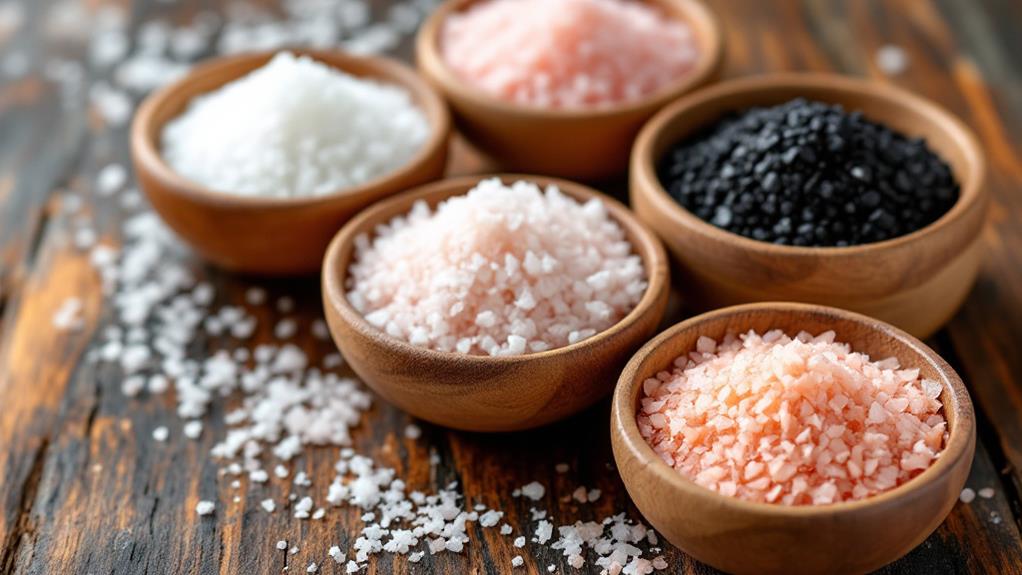
When it comes to selecting the right salt for your culinary needs, comprehending the differences between various salt types can make all the difference. Table salt, often referred to as refined salt, is your go-to for its consistency and affordability. It's typically iodized to support thyroid health and contains anti-caking agents, ensuring it flows freely. Sea salt, on the other hand, originates from evaporated seawater and includes trace elements, offering a unique flavor profile that's less uniform than table salt.
Kosher salt stands out with its larger, coarser crystals, making it easy to pinch and sprinkle. Chefs love it for seasoning because it doesn't have additives, allowing for precise control over the saltiness in dishes. Then there's Himalayan pink salt, mined from ancient sea deposits. Its pink hue comes from trace minerals, although its supposed health benefits remain largely anecdotal.
For those final touches on your dishes, consider using a finishing salt like flake salt. Its light, flaky texture adds a satisfying crunch and burst of flavor right before serving. With these different kinds of salt, you can improve your cooking by choosing the variety that best suits your taste and textural preferences.
Table Salt in Cooking
Improving your dishes with table salt involves understanding its quick-dissolving properties and sharp flavor. As a staple in your kitchen, this iodized seasoning is perfect for cooking, especially when you add it to boiling water for pasta. Its fine crystals dissolve quickly, ensuring even distribution and improving flavor absorption throughout your dish. However, it's important to be mindful of your sodium intake, as table salt contributes considerably to your daily limit of around 2,300 mg.
In culinary applications, table salt's versatility shines, but it's vital to know when it's the right choice:
- Quick-dissolving: Ideal for seasoning during cooking rather than finishing.
- Flavor absorption: Improves dishes like pasta or soup when added early.
- Iodized benefits: Helps prevent iodine deficiency in your diet.
- Density considerations: Not a direct substitute for coarser salts like kosher salt; adjust measurements accordingly.
Health Implications of Salt

Understanding the health implications of salt is crucial for maintaining a balanced diet. Excessive sodium intake, mainly from processed foods, is a significant contributor to health issues like high blood pressure, heart disease, and stroke. Most adults should aim to keep their sodium intake below 2,300 mg per day. However, people with hypertension may need to reduce it further, using salt substitutes or alternative seasonings to add flavor without the extra sodium.
Iodized table salt offers health benefits by preventing iodine deficiency, which can lead to thyroid problems and goiters. This is especially necessary in areas where the soil lacks iodine. Consuming iodized salt helps guarantee you get enough iodine to support thyroid health.
Since most sodium comes from packaged and restaurant foods, it's crucial to read Nutrition Facts labels. This helps you make informed choices about your sodium intake and manage your health better. Health organizations like the FDA are working with the food industry to cut sodium levels in processed foods, aiming for better public health outcomes. Being mindful of your sodium intake and opting for iodized table salt can help maintain your health.
Storing and Handling Salt
Proper storage and handling of table salt guarantee it remains a staple in your kitchen, free-flowing and ready for use. To achieve this, you should store your table salt in an airtight container. This prevents moisture absorption, which can lead to clumping and spoil its usability. Keep the container in a cool, dry place, away from direct sunlight and heat sources, to maintain the salt's flavor and quality over time.
Using a dedicated salt scoop or spoon will help you avoid introducing moisture and contaminants from your hands into the salt. It's crucial to avoid salt containers that have been in contact with any moisture or liquids to prevent contamination and spoilage. Although salt usually has an indefinite shelf life when properly stored, you should regularly check the expiration date on packaged salt to confirm its effectiveness.
Here are some key points to remember:
- Airtight container: Keeps moisture out and salt flowing.
- Cool, dry place: Preserves flavor and quality.
- Dedicated scoop: Minimizes contamination risk.
- Expiration date: Regular checks confirm effectiveness.
Following these steps will keep your table salt fresh and ready to elevate your meals.
Table Salt Alternatives
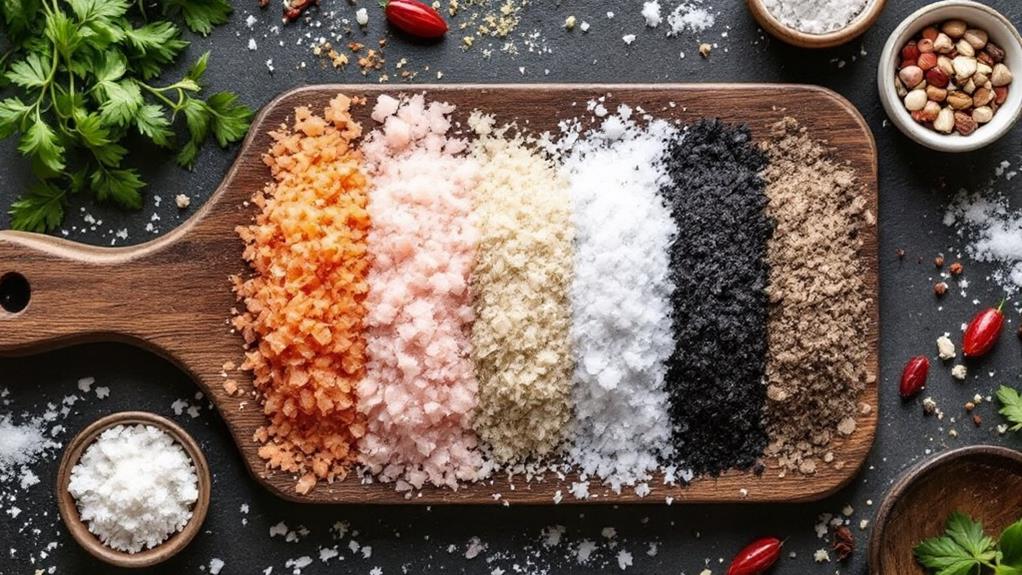
Exploration of table salt alternatives opens a world of flavors and textures to improve your culinary creations. Each type of salt offers unique characteristics that can raise your dishes. Kosher salt, with its larger crystals and lack of additives, is a favorite for cooking and seasoning. It's great at drawing out moisture from meats, making it ideal for brining.
Sea salt, harvested from evaporated seawater, contains trace minerals that enrich flavor. It's a go-to in gourmet cooking and can provide a more complex taste than regular table salt. Himalayan pink salt stands out with its stunning color and mineral-rich profile. Besides its culinary uses, it often graces tables as a decorative touch.
Flake salt, with its light, flaky texture, dissolves quickly, adding a burst of flavor and a pleasant crunch when sprinkled just before serving. If you're watching your sodium intake, low sodium salt offers a smart alternative. By replacing some sodium with potassium, it helps reduce sodium consumption without sacrificing flavor.
Unlike table salt, which often has added iodine, these alternatives provide diverse options suited to different types of salt preferences and dietary needs.
Using Salt in Baking
While baking might seem like a straightforward process, the role of salt is anything but simple. Salt not only boosts flavor but also balances sweetness and affects the texture of your baked goods. Even a small amount can greatly impact the final product. In terms of choosing between table salt and kosher salt, each has its unique benefits. Kosher salt, with its larger, coarser grains, allows for even distribution and more accurate measurements. This can be vital in baking, where precision matters.
Consider these tips for using salt effectively in baking:
- Flavor Amplifier: A pinch of salt can amplify natural flavors, making your baked goods more delicious.
- Hydration Balance: Fine table salt dissolves quickly, affecting dough or batter hydration, while coarser salts might require adjustments in liquid ratios.
- Ingredient Improvement: Salting ingredients like butter can raise the complete flavor profile.
- Density Variations: Be mindful of different salt densities; for instance, 1 teaspoon of table salt equals about 1.5 teaspoons of kosher salt.
Always follow recipe specifications to guarantee you're using the right type and amount of salt for the best baking results.
Salt in Preservation Techniques
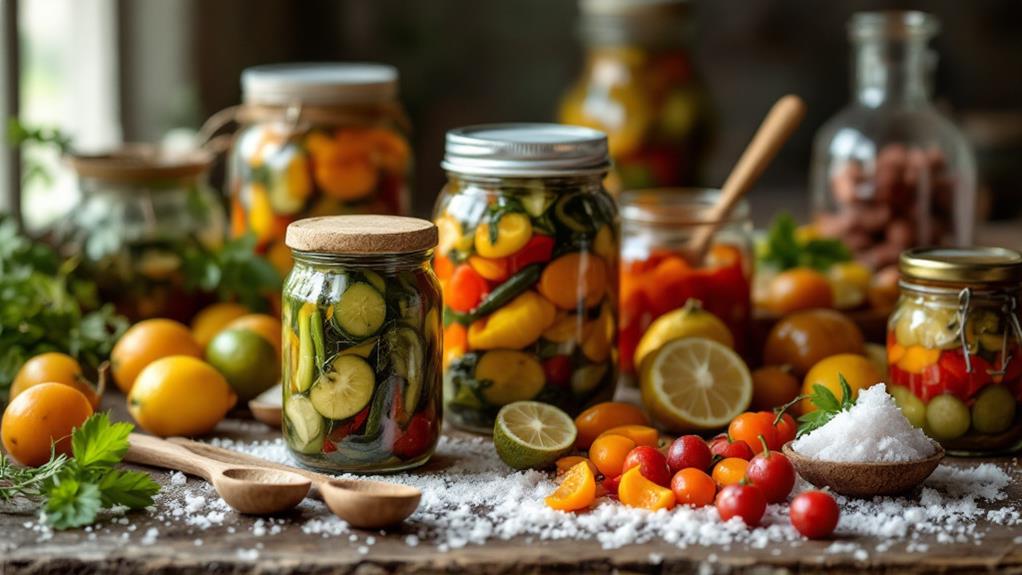
Throughout history, salt has been a cornerstone in food preservation techniques, transforming the way we store and enjoy perishable items. Salt acts as a natural preservative by drawing moisture out of food, creating an environment that inhibits bacterial growth and spoilage. This is essential for long-term storage, especially in regions with limited access to fresh food sources.
Curing is one of the most effective methods that utilizes salt. By dehydrating meats and fish, salt creates delicacies like prosciutto and salami that can be safely stored for extended periods. This method not only preserves but also improves flavors, making them more robust and enjoyable.
Pickling is another popular technique where salt is combined with vinegar and sugar. This mixture preserves vegetables and fruits, enriching their flavor and preventing spoilage through osmosis. For clear and effective brines, using non-iodized salt such as pickling salt is recommended. It prevents cloudiness and guarantees the preservation process is successful.
In the age before refrigeration, these salt-based methods were essential for food preservation. They allowed people to enjoy a variety of foods regardless of the season, securing sustenance and delight year-round.
Engaging With Salt Communities
Joining salt communities offers a unique opportunity to immerse yourself in the world of culinary exploration, where enthusiasts and professionals share invaluable insights and experiences. By engaging with these communities, you can reveal culinary tips, exchange ideas on different salt types, and uncover unique flavors that can enhance your dishes. Salt communities thrive on platforms like Facebook and Instagram, where you can showcase your creations, post mouth-watering photos, and pick up advice on salt usage.
Online forums and blogs are valuable sources of information, often exploring the health implications of different salts. These discussions can guide you in making informed choices about sodium intake, aligning with your dietary preferences. Participation in these communities fosters a sense of belonging and offers a chance to learn from others who share your passion.
Consider joining local cooking classes or workshops organized by salt communities. These hands-on experiences allow you to experiment with a range of salts, enhancing your culinary skills and knowledge. Engaging with salt communities can offer you:
- A platform to share and gain culinary tips.
- Insights into the unique flavors of different salt types.
- Knowledge about the health implications of salt.
- Opportunities to join cooking classes for practical experience.

